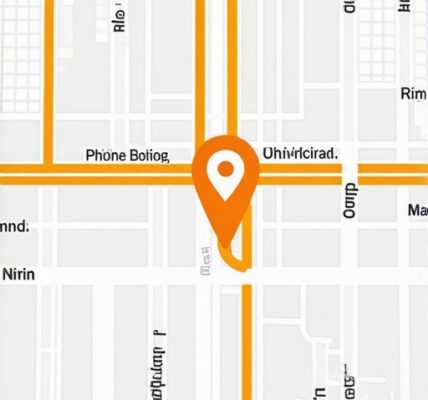When Was the Last Time You Actually Used a Paper Map?
Remember those bulky fold-out maps that used to live in your glove compartment or back pocket? Now, they’re mostly relics, replaced by the sleek convenience of Google Maps. But beyond just getting you from point A to point B, Google Maps has quietly become a powerhouse tool for local businesses aiming to attract nearby customers. If you think Google Maps SEO is just about pinning your location, think again. It’s a dynamic strategy that, when mastered, can turn foot traffic from a trickle into a flood.
Let’s Talk Strategy: How Does Google Maps SEO Actually Work?
Google Maps SEO is all about optimizing your business’s presence on Google so that it pops up in those coveted local search results. This means when someone nearby searches for services or products you offer, your business – not just a random competitor – shows up first. The magic ingredients? A well-crafted Google Business Profile, consistent citations, positive reviews, and savvy keyword use. The goal is to rank high, ideally in that golden “Google 3-Pack” – the top three local listings Google showcases.
Is It Really That Simple or Is There More Under the Hood?
Here’s the kicker: while it sounds straightforward, the competition is fierce. Businesses that neglect local SEO optimization often find themselves buried beneath the noise. The truth is, effective Google Maps SEO requires strategic finesse—leveraging quality backlinks, managing citations meticulously, and continuously updating your Google Business Profile with fresh photos and posts to stay relevant.
Experience Speaks Louder Than Keywords
From my own observations working with small businesses, those who engage genuinely with their customers on Google Maps—responding to reviews, sharing timely updates, and showcasing their unique story—tend to see a noticeable uptick in nearby customer engagement. It’s not just about SEO mechanics; it’s about crafting an authentic digital storefront that invites trust. After all, as Moz’s local SEO insights highlight, trustworthiness and engagement are key ranking factors.
Ready to Turn Your Location Into Your Greatest Asset?
Whether you’re a cozy coffee shop or a bustling boutique, mastering Google Maps SEO can be your secret weapon to dominate the local scene. Curious to dive deeper? Explore expert tips on unlocking Google Maps SEO that elevate your local visibility. And if you’ve got stories or questions about your own local SEO journey, don’t hesitate to share them below. After all, the best strategies emerge from shared experiences!
Leveraging Advanced Features to Amplify Your Google Maps Presence
Once you have the basics of Google Maps SEO down, it’s time to explore how advanced features can significantly boost your local visibility. For example, utilizing Google Posts within your Google Business Profile allows you to communicate timely offers, events, or news directly to potential customers in your vicinity. These posts not only keep your profile fresh but also improve engagement signals that Google values for ranking.
Another underutilized tactic is optimizing your service areas if you serve multiple neighborhoods or regions. Clearly defining these areas in your profile ensures you capture relevant “near-me” searches, a rapidly growing segment of local queries. Combine this with detailed business descriptions enriched with targeted keywords to enhance your profile’s relevance.
How Can Integrating User-Generated Content Transform Your Local SEO Impact?
User-generated content (UGC) such as customer photos, reviews, and Q&A interactions have become crucial signals of authenticity and trustworthiness. Encouraging customers to share their experiences, reply to their queries promptly, and showcase these interactions can set your listing apart. According to Search Engine Land’s 2024 Local SEO Guide, businesses that actively manage and leverage UGC see an average 25% increase in local search visibility compared to those that do not.
Moreover, the strategic use of Google Maps features such as booking integrations, menu displays, and product catalogs can convert searchers into customers without requiring them to leave the platform. These enhancements contribute to better user experience and, consequently, higher rankings.
Ensuring Consistency and Authority Through Citation Management
Citation consistency remains a cornerstone of effective local SEO. Discrepancies in your NAP (Name, Address, Phone Number) across various directories can confuse search engines and reduce trust signals. Investing in expert citation services ensures your business information is accurate and authoritative across the web, which is critical for climbing local rankings.
For a comprehensive approach, consider conducting a GMB SEO audit to identify citation inconsistencies and other ranking obstacles. This audit will provide actionable insights to refine your Google Business Profile and overall local SEO strategy.
Additionally, building high-quality backlinks from local websites and industry-relevant domains can enhance your domain authority and trustworthiness. These efforts complement your citation management and signal to Google that your business is a credible local entity.
By combining these advanced tactics with the foundational strategies discussed earlier, you position your business not just to appear but to dominate in Google Maps local search results.
For more advanced insights and practical tips on optimizing your Google Business Profile, consider exploring this comprehensive guide that dives deeper into each element of Google Maps SEO.
Have you experimented with any of these advanced Google Maps SEO tactics? Share your experiences or questions below to join the conversation and help others elevate their local search presence!
Decoding the Nuances of Google Maps Ranking Algorithm: Beyond the Basics
While many businesses focus on the visible elements like reviews and citations, the Google Maps ranking algorithm incorporates a complex interplay of factors that demand a more nuanced understanding. For instance, proximity remains a critical factor, but it’s not simply about physical distance. Google weighs user location intent, historical search behavior, and even the time of day to determine which listings to prioritize. This means that optimizing for Google Maps SEO isn’t just about stuffing keywords or accumulating reviews; it’s about crafting a dynamic profile that aligns with evolving user intent signals.
Moreover, behavioral metrics such as click-through rates on your profile, direction requests, and call actions feed back into the ranking algorithm, signaling user engagement and relevance. This feedback loop creates opportunities for businesses to influence their rankings by enhancing user interaction features and providing compelling calls to action that encourage deeper engagement.
How Do Behavioral Signals Influence Google Maps SEO Rankings in Competitive Markets?
In saturated markets where many businesses share similar basic SEO optimizations, behavioral signals often become the decisive differentiator. Google interprets high engagement metrics—like frequent requests for directions or sustained profile visits—as indicators of superior relevance and user satisfaction. Therefore, businesses that invest in interactive content such as virtual tours, timely Google Posts, or seamless booking integrations can significantly boost these behavioral metrics.
Furthermore, responding promptly to reviews and user questions not only demonstrates active engagement but also increases the likelihood of repeat interactions, reinforcing your profile’s authority. According to a recent study by BrightLocal’s 2024 Local Consumer Review Survey, businesses that responded to 50% or more of their reviews saw a 15% increase in customer engagement and a 22% uplift in local search rankings.
Harnessing Artificial Intelligence and Automation in Google Maps SEO Management
With the rise of AI-powered tools, managing and optimizing your Google Business Profile can be elevated to a new level of precision and efficiency. AI-driven platforms enable real-time sentiment analysis of customer reviews, allowing businesses to swiftly identify and address negative feedback before it impacts reputation. Additionally, automation can streamline citation audits, ensuring your NAP consistency remains impeccable across hundreds of directories without manual effort.
Advanced tools also facilitate keyword gap analysis against competitors, highlighting untapped opportunities within your local market. This strategic intelligence empowers businesses to tailor their Google Maps SEO efforts with surgical precision, focusing resources on the most impactful optimization levers.
What Are the Risks and Rewards of Relying on Automation for Google Maps SEO?
While automation accelerates many routine tasks, over-reliance without strategic oversight can backfire. For example, automated review responses that lack personalization may come across as insincere, potentially alienating customers. Similarly, AI-generated content must be carefully reviewed to ensure it aligns with brand voice and avoids keyword stuffing that Google penalizes.
Nonetheless, when combined with expert human judgment, AI and automation become powerful allies in maintaining a vibrant, responsive, and optimized Google Business Profile that consistently outperforms competitors.
Exploring these advanced tactics requires a blend of technical savvy and strategic creativity. For those ready to dive deeper, consider partnering with local SEO experts or leveraging specialized AI tools designed specifically for Google Maps optimization.
Feeling inspired to refine your Google Maps SEO with these cutting-edge approaches? Join the conversation below to share your experiences or ask questions. Your insights could be the catalyst for another business’s breakthrough in local search dominance!
Unveiling the Power of Behavioral Analytics in Local Search Dominance
While traditional SEO elements like citations and reviews form the backbone of Google Maps optimization, the next frontier lies in harnessing behavioral analytics. Understanding how potential customers interact with your Google Business Profile—whether they click on your photos, request directions, or even engage with your Q&A section—can reveal actionable insights. Businesses that refine their profiles based on these user behaviors often enjoy superior local rankings because Google interprets these signals as proof of relevance and value.
Integrating tools that monitor these user interactions allows for iterative improvements, ensuring your profile evolves in sync with consumer expectations. For small businesses eager to elevate their local presence, adopting a data-driven approach transforms Google Maps SEO from a set-it-and-forget-it task into a dynamic growth strategy. Explore more about auditing your local search performance through comprehensive GMB SEO audits to identify these key behavioral trends.
How Can Behavioral Data Be Leveraged to Outrank Competitors in Hyper-Competitive Local Markets?
In markets saturated with similar offerings, standing out requires more than basic SEO compliance. Behavioral data—like click-through rates, engagement time on your profile, and the frequency of direct interactions—serve as crucial differentiators. Businesses can optimize their Google Business Profiles by creating compelling, interactive content such as virtual tours or video testimonials, which not only boost engagement metrics but also foster trust.
Moreover, prompt and personalized responses to reviews and questions elevate customer satisfaction and encourage repeat visits, which in turn enhance your profile’s authority. According to a 2024 study by Search Engine Land, active engagement with user-generated content correlates with a 30% increase in local search rankings, underscoring the importance of behavioral signal optimization.
Embedding AI-Driven Personalization to Revolutionize Your Google Maps Presence
The infusion of artificial intelligence and machine learning into Google Maps SEO is reshaping how businesses connect with local audiences. AI-powered personalization algorithms can tailor your Google Business Profile content dynamically based on user preferences, search history, and real-time intent signals. This level of customization ensures that your business appears more relevant to each individual searcher, thereby increasing conversion potential.
Utilizing AI tools for sentiment analysis helps businesses proactively manage reputation by swiftly addressing negative feedback and amplifying positive reviews. When combined with automation for citation consistency and keyword optimization, AI becomes an indispensable ally in sustaining competitive edge.
What Are the Best Practices for Integrating AI Without Losing the Human Touch in Local SEO?
While AI offers remarkable efficiency, maintaining authentic human engagement remains paramount. Over-automated responses risk alienating customers if they lack warmth and contextual relevance. The ideal strategy blends AI’s analytical power with personalized, empathetic communications. For example, AI can flag reviews needing responses, but human-crafted replies ensure genuine connection.
To strike this balance, consider leveraging expert insights and tools like those detailed in comprehensive Google Business SEO guides, which provide frameworks for combining automation with thoughtful engagement effectively.
Invitation to Innovate: Share Your Advanced Google Maps SEO Experiences
Have you experimented with leveraging behavioral analytics or AI-powered personalization in your local SEO efforts? What challenges or successes have you encountered? Your stories and insights could illuminate paths for others navigating the complex terrain of Google Maps optimization.
Join the conversation by leaving a comment below or explore more expert strategies in unlocking Google Maps SEO tips to continuously elevate your local search presence.

Expert Insights & Advanced Considerations
Embrace Behavioral Signals as a Competitive Edge
While traditional SEO components like citations and reviews form the foundation of Google Maps SEO, the decisive factor in competitive markets increasingly lies in behavioral signals. Metrics such as click-through rates, direction requests, and profile engagement provide Google with critical user intent data, signaling relevance beyond mere keyword presence. Businesses that actively enhance user interaction—through virtual tours, immersive content, or booking integrations—can leverage these signals to elevate their rankings substantially.
AI Augmentation Requires a Human-Centric Approach
Artificial intelligence and automation tools offer unparalleled efficiency for managing Google Business Profiles, from sentiment analysis of reviews to citation consistency. However, over-automation risks alienating users if personalization and authentic engagement are sacrificed. The ideal strategy synthesizes AI’s analytic power with genuine human responsiveness, ensuring that automated insights translate into meaningful, empathetic customer interactions.
Consistency in NAP and Citation Management Remains Non-Negotiable
Despite evolving ranking algorithms, maintaining absolute consistency in your Name, Address, and Phone Number across all directories continues to be a cornerstone of effective local SEO. Inconsistencies can confuse search engines and dilute trust signals, undermining your authority. Investing in expert citation services and conducting thorough GMB SEO audits are pivotal steps to ensure that your business information is both accurate and authoritative.
Optimize for ‘Near Me’ and Hyperlocal Search Intents
With the surge in mobile and voice searches, queries containing “near me” or ultra-specific local intents have become dominant. Tailoring your Google Business Profile and content strategy to capture these searches by accurately defining your service areas and integrating localized keywords enhances your visibility. Strategies outlined in local SEO guides provide actionable frameworks for this essential optimization.
Curated Expert Resources
BrightLocal Local Consumer Review Survey 2024: Offers comprehensive data on how review management impacts customer engagement and local rankings, essential for understanding behavioral influence on SEO.
Search Engine Land’s 2024 Local SEO Guide: A definitive resource on emerging local SEO best practices, including user-generated content strategies and behavioral analytics integration.
RankingSEOgmb.com Comprehensive Google Business Profile Guides: Featuring in-depth articles such as Mastering Google Business SEO and Expert GMB Citation Services, these guides provide tactical insights tailored for small businesses aiming to dominate local search.
BrightLocal’s Review Generation and Management Tools: Practical tools and methodologies to automate and personalize review solicitation and responses, crucial for sustaining positive behavioral signals.
Google’s Own Local SEO Best Practices: Direct insights and updates from Google provide authoritative guidance on algorithm changes and feature utilization within Google Maps SEO.
Final Expert Perspective
Google Maps SEO is no longer a static checklist but a dynamic interplay of authenticity, behavioral engagement, and strategic innovation. Mastery involves synthesizing foundational practices—like citation consistency and profile optimization—with emerging tactics such as AI-driven personalization and behavioral analytics. Local businesses that prioritize genuine customer interaction while leveraging advanced tools position themselves not just to appear in local search but to dominate their neighborhoods.
For those ready to deepen their expertise, exploring resources like unlocking Google Maps SEO tips and conducting comprehensive GMB SEO audits can illuminate pathways to sustained local search success. Share your advanced strategies or questions below—your professional insights might just inspire the next breakthrough in local SEO mastery.



This article really highlights how vital ongoing engagement is for local SEO success on Google Maps. From my experience managing a small bookstore’s profile, I found that regularly posting updates and responding to reviews made a noticeable difference in visibility. I’m curious about the role of AI tools in automating some of these interactions—do you think they risk losing the personal touch that customers value? Also, what’s the best way to find those hidden behavioral signals that can provide a competitive edge in such a saturated market? I’d love to hear how others integrate these advanced tactics without sacrificing authenticity, as that seems crucial for building trust in my community.